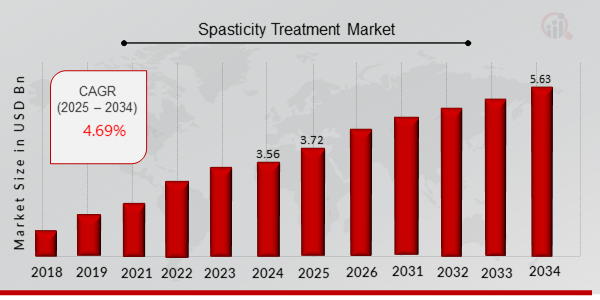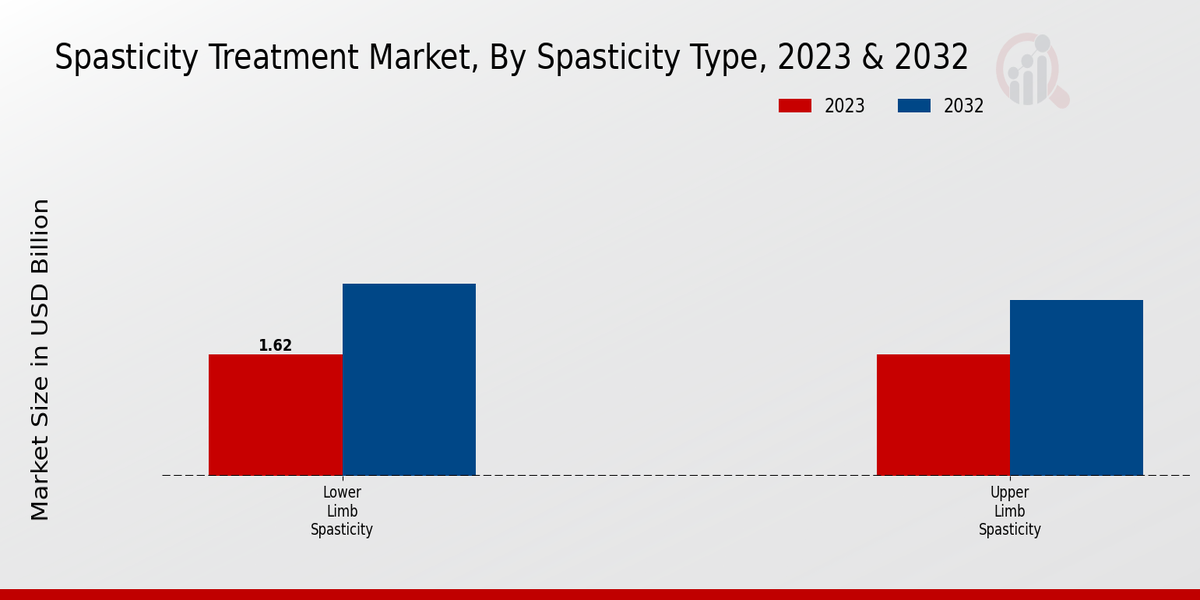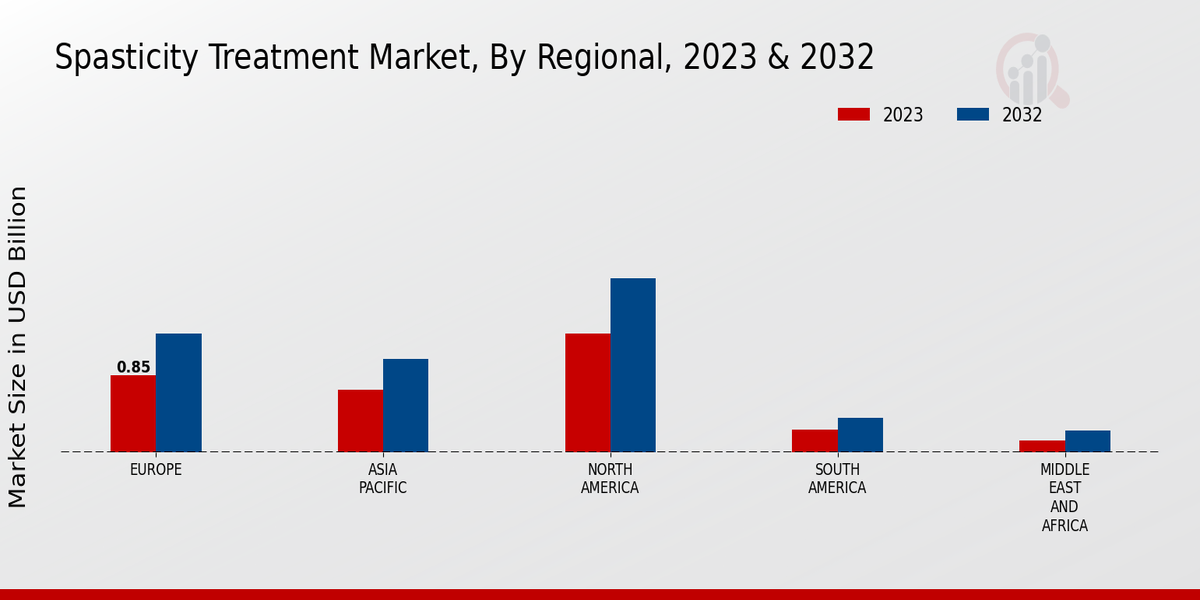As per MRFR analysis, the Spasticity Treatment Market Size was estimated at 3.56 (USD Billion) in 2024. The Spasticity Treatment Market Industry is expected
Spasticity Treatment Market Overview
to grow from 3.72 (USD Billion) in 2025 to 5.63 (USD Billion) till 2034, at a CAGR (growth rate) is expected to be around 4.69% during the forecast period (2025 - 2034).
Key Spasticity Treatment Market Trends Highlighted
The spasticity treatment market is expanding due to rising prevalence of neurological disorders, advancements in treatment options, and increasing awareness about spasticity management. Growing geriatric population and increasing incidence of spinal cord injuries are also key market drivers.
Recent trends in the market include the emergence of non-invasive treatments such as botulinum toxin injections, physical therapy, and neurostimulation devices. Technological advancements in surgical techniques and the development of novel pharmaceutical therapies are also driving market growth.
Opportunities for exploration include the development of personalized treatment plans based on patient-specific needs, the integration of artificial intelligence in spasticity management, and the use of telemedicine for remote patient monitoring.
Partnerships between healthcare providers, pharmaceutical companies, and medical device manufacturers can drive innovation and improve patient outcomes. By leveraging these trends and opportunities, the spasticity treatment market is poised for significant growth in the coming years.

Source Primary Research, Secondary Research, MRFR Database and Analyst Review
Spasticity Treatment Market Drivers
Growing Prevalence of Neurological Disorders
The rising incidence of neurological disorders, such as stroke, cerebral palsy, and multiple sclerosis, is a major driver of the spasticity treatment market.
These conditions can lead to muscle stiffness and spasms, which can significantly impair mobility and quality of life. As the population ages and the prevalence of these disorders increases, the demand for effective spasticity treatments is expected to grow.
According to the World Health Organization (WHO), stroke affects approximately 15 million people worldwide each year, and cerebral palsy affects around 17 million children.
Multiple sclerosis is estimated to affect over 2.8 million people globally. These disorders can cause a range of symptoms, including muscle weakness, spasticity, and impaired coordination. The growing prevalence of neurological disorders is creating a significant unmet medical need for effective spasticity treatments.
This is driving research and development efforts in the pharmaceutical industry, as well as increasing investment in new treatment modalities, such as botulinum toxin injections and neuromodulation devices.
Technological Advancements in Treatment Options
Advancements in medical technology are leading to the development of new and more effective treatments for spasticity. These include minimally invasive procedures, such as botulinum toxin injections and selective dorsal rhizotomy, as well as non-invasive therapies, such as electrical stimulation and physical therapy.
Botulinum toxin injections involve injecting a purified form of the botulinum toxin into the affected muscles. This toxin blocks nerve signals, reducing muscle spasms and stiffness.
Selective dorsal rhizotomy is a surgical procedure that involves cutting the sensory nerve roots that transmit pain and spasticity signals from the spinal cord to the muscles. Electrical stimulation and physical therapy are non-invasive treatments that can help to improve muscle function and reduce spasticity.
Electrical stimulation involves using electrical impulses to stimulate the nerves and muscles, while physical therapy focuses on stretching and strengthening exercises to improve flexibility and range of motion.
The availability of these advanced treatment options is improving the quality of life for people with spasticity and is expected to drive the growth of the spasticity treatment market in the coming years.
Increasing Awareness and Acceptance of Spasticity Treatments
Spasticity has been traditionally underdiagnosed and under-treated in the past. Nevertheless, due to the increasing awareness of the issue, there is an increased demand for treatments for it and the corresponding increase in the readiness of people to seek therapies.
Among the factors that contribute to the issue of spasticity being recognized, one must mention the impact of public health campaigns and educational programs designed to help people identify the symptoms and signs of the condition, as well as raise awareness about the benefits of being diagnosed as soon as possible and obtaining the necessary treatment.
It should be noted that the rise in the acceptance of spasticity treatments can be justified by the population of people living with the disorder. The significant increase in rates of neurological diseases implies that more and more people suffer from the problem, thus making it more accepted and less stigmatized.
Spasticity Treatment Market Segment Insights
Spasticity Treatment Market Spasticity Type Insights
Among the various segments within this market, the Spasticity Type segment reveals crucial information about its dynamics. Within this segment, Upper Limb Spasticity and Lower Limb Spasticity stood out as pivotal areas.
The Upper Limb Spasticity was valued at 1.62 USD Billion in 2023, while the Lower Limb Spasticity was also valued at 1.62 USD Billion in the same year. This equal valuation underscored a balanced market interest; however, Lower Limb Spasticity is projected to attain a higher valuation of 2.56 USD Billion by 2032.
This growth in the Lower Limb Spasticity treatment indicates a rising awareness around conditions affecting lower limb functioning, perhaps owing to an aging population and increasing incidents of conditions like stroke or traumatic brain injury that often lead to spasticity in the legs.
Meanwhile, Upper Limb Spasticity is anticipated to grow to 2.34 USD Billion by 2032, presenting a steady demand for treatment alternatives for patients struggling with arm and hand movement issues. Together, these spasticity types reflected key components of the Spasticity Treatment Market segmentation.
Market trends indicate an increase in innovative therapies and pharmacological advancements that target these specific conditions, further driving their growth. The increasing prevalence of neurological disorders, coupled with ongoing research, presents ample opportunities within this market, urging market players to invest in developing tailored therapeutic solutions.
Challenges remain, such as supply chain issues and regulatory hurdles that may impact product availability. However, both Upper and Lower Limb Spasticity types dominate the discussion around treatment modalities, demonstrating their importance in addressing the needs of a significant patient demographic.
Enhanced healthcare infrastructure and patient access to treatment are factors that can significantly influence overall market growth and drive the statistics surrounding the Spasticity Treatment Market forward.
The data reflects an ever-evolving landscape for the Spasticity Treatment Market, where both Upper and Lower Limb Spasticity are key factors determining the strategies and innovations to meet patient needs effectively.

Source Primary Research, Secondary Research, MRFR Database and Analyst Review
Spasticity Treatment Market Treatment Type Insights
Among different sub-segments, Injectable Drugs Delivery are typically favored due to their targeted delivery mechanism and quick action, making them integral in managing spasticity. Oral Medications also play a vital role, offering a convenient alternative for long-term management and enhancing patient compliance.
Surgery is a critical treatment option for severe cases where other methods may not provide adequate relief, reflecting its significance in the overall treatment landscape.
Additionally, Physical Therapy is essential for rehabilitation, helping patients regain function and improve quality of life, thereby complementing medicinal treatments effectively. The diversity within the treatment types highlights the importance of a tailored approach in the Spasticity Treatment Market, catering to varying patient needs and contributing to the market growth.
As this sector evolves, addressing the challenges and opportunities in each treatment category will be pivotal for advancements and innovations in spasticity care.
Spasticity Treatment Market Indication Insights
The segment comprises conditions like Cerebral Palsy, Multiple Sclerosis, Spinal Cord Injury, and Stroke, each representing critical areas where effective treatment solutions are essential. Cerebral Palsy dominates this market, as it is a common cause of spasticity in children.
Furthermore, Multiple Sclerosis and Spinal Cord Injury are significant contributors to the overall market, both requiring innovative therapeutic approaches to manage symptoms and improve quality of life.
Stroke, as a leading cause of long-term disability, makes this segment particularly vital for patient rehabilitation and recovery efforts.
Increasing awareness, advancements in treatment options, and the growing aging population contributing to the prevalence of these conditions are driving market growth while highlighting the challenges in accessibility and affordability of care for patients with spasticity-related conditions.
Spasticity Treatment Market End User Insights
The Spasticity Treatment Market demonstrates a robust structure centered around various End Users, including Hospitals, Clinics, and Rehabilitation Centers. Hospitals play a pivotal role in this market due to their capacity to provide comprehensive care and advanced treatment options, attracting a significant share of the overall market revenue.
Clinics contribute greatly as well, offering specialized services and accessibility for patients seeking targeted treatment. Rehabilitation Centers are also crucial, focusing on long-term recovery solutions that are essential for individuals with spasticity-related conditions.
Each of these End Users supports a critical framework within the Spasticity Treatment Market, ensuring effective patient management, widespread accessibility to novel therapies, and the potential for ongoing patient engagement.
The growth within this market can be attributed to increased awareness of spasticity and evolving treatment modalities, although challenges such as funding and resource allocation remain pertinent.
The overall market statistics reflect a steady incline, presenting ample opportunities for market players to innovate and enhance their service offerings across these vital End User settings.
Spasticity Treatment Market Regional Insights
The Spasticity Treatment Market is projected to reach significant valuations across various regions, with North America holding a majority share valued at 1.32 USD billion in 2023 and expected to grow to 1.93 USD billion by 2032. This region represented a robust demand for innovative treatment therapies and advanced healthcare infrastructure, making it a pivotal area for market growth.
Europe followed with a valuation of 0.85 USD billion in 2023, increasing to 1.32 USD billion in 2032, driven by extensive research and development activities. Asia Pacific, another vital region, was valued at 0.69 USD billion in 2023, with a growth trajectory towards 1.03 USD billion by 2032 due to a rising patient population and increasing healthcare access.
South America, while smaller with 0.25 USD billion in 2023, signified potential growth opportunities reaching 0.38 USD billion in 2032, impacted by improving healthcare systems. The Middle East and Africa showed modest values at 0.13 USD billion in 2023, likely rising to 0.24 USD billion by 2032, driven by increasing healthcare investments.
These regional insights reflected significant factors affecting the Spasticity Treatment Market revenue and direct future segmentation trends as the industry adapts to changing healthcare needs and patient demographics.

Source Primary Research, Secondary Research, MRFR Database and Analyst Review
Spasticity Treatment Market Key Players And Competitive Insights
The Spasticity Treatment Market boasts of major players actively partaking in the development of novel products to gain a competitive edge in the market. The primary Spasticity Treatment Market players are engaged in strategic partnerships and acquisition of other industries to increase the product range of Spasticity Treatment Market firms.
The Spasticity Treatment Market is extremely competitive due to high investment by companies in outbound and inbound research. One of the main players in the Spasticity Treatment Market is Allergan. Allergan possesses a range of branded products for spasticity treatment.
BOTOX is a neurotoxin that is injected into muscles to lessen muscle spasms. Additionally, DYSPORT is another neurotoxin that is equivalent to BOTOX and also aids in the treatment of various movement disorders.
Allergan has also advertised a number of new products in the pipeline to extend its offerings, thereby enabling it to seize the lead position. The main competitor in the Spasticity Treatment Market is Merz Therapeutics.
Xeomin is the product of Merz, which is equivalent to BOTOX and is a neurotoxin used to treat muscle spasms. Additionally, Dysport is another neurotoxin of Merz used to treat a number of movement disorders.
Merz has also publicized the products it intends to launch in the Spasticity Treatment Market in the future.
Key Companies in the Spasticity Treatment Market Include
- NuVasive
- Deuy
- Medtronic
- Allergan
- Baxter
- Stryker
- Merz Pharma GmbH Co
- Johnson Johnson
- Novartis
- Teva
- Boston Scientific
- Smith Nephew
- Abbott
- Merz
- Ipsen
Spasticity Treatment Market Developments
Key factors driving market growth include the increasing prevalence of neurological disorders such as cerebral palsy and multiple sclerosis, rising demand for minimally invasive procedures, and growing awareness of spasticity management techniques.
Recent news developments include the FDA approval of new drugs for spasticity treatment, such as botulinum toxin type A (Botox) and baclofen, and the emergence of novel technologies like robotic rehabilitation and electrical stimulation.
These advancements are expected to further fuel market growth in the coming years.
Spasticity Treatment Market Segmentation Insights
Spasticity Treatment Market Spasticity Type Outlook
- Upper Limb Spasticity
- Lower Limb Spasticity
Spasticity Treatment Market Treatment Type Outlook
- Injectable Drugs
- Oral Medications
- Surgery
- Physical Therapy
Spasticity Treatment Market Indication Outlook
- Cerebral Palsy
- Multiple Sclerosis
- Spinal Cord Injury
- Stroke
Spasticity Treatment Market End User Outlook
- Hospitals
- Clinics
- Rehabilitation Centers
Spasticity Treatment Market Regional Outlook
- North America
- Europe
- South America
- Asia Pacific
- Middle East and Africa
Spasticity Treatment Market Report Scope
| Report Attribute/Metric |
Details |
|
Market Size 2024
|
3.56 (USD Billion)
|
|
Market Size 2025
|
3.72 (USD Billion)
|
|
Market Size 2034
|
5.63 (USD Billion)
|
|
Compound Annual Growth Rate (CAGR)
|
4.69 % (2025 - 2034)
|
|
Report Coverage
|
Revenue Forecast, Competitive Landscape, Growth Factors, and Trends
|
|
Base Year
|
2024
|
|
Market Forecast Period
|
2025 - 2034
|
|
Historical Data
|
2020 - 2024
|
| Market Forecast Units |
USD Billion |
| Key Companies Profiled |
NuVasive, DePuy, Medtronic, Allergan, Baxter, Stryker, Merz Pharma GmbH Co, Johnson Johnson, Novartis, Teva, Boston Scientific, Smith Nephew, Abbott, Merz, Ipsen |
| Segments Covered |
Spasticity Type, Treatment Type, Indication, End User, Regional |
| Key Market Opportunities |
Rising prevalence of chronic diseases Technological advancements in spasticity management Growing demand for minimally invasive procedures Expansion of rehabilitation services Increasing healthcare expenditure in emerging economies |
| Key Market Dynamics |
The rising prevalence of technological advancements, favorable reimbursement policies, increasing awareness |
| Countries Covered |
North America, Europe, APAC, South America, MEA |
Frequently Asked Questions (FAQ) :
The Spasticity Treatment Market is expected to be valued at 5.63 USD Billion by 2034.
The expected CAGR for the Spasticity Treatment Market from 2025 to 2034 is 4.69%.
North America is projected to have the largest market size for Spasticity Treatment at 1.93 USD Billion by 2032.
The market value for Upper Limb Spasticity was 1.62 USD Billion in 2023.
The Asia Pacific region is expected to contribute 1.03 USD Billion to the Spasticity Treatment Market by 2032.
The market value for Lower Limb Spasticity is anticipated to be 2.56 USD Billion in 2032.
Major players in the Spasticity Treatment Market include Medtronic, Allergan, and Johnson Johnson.
The expected market size for Europe in 2032 is 1.32 USD Billion.
The South American market for Spasticity Treatment is expected to grow to 0.38 USD Billion by 2032.
The market value for the Middle East and Africa region in 2023 was 0.13 USD Billion.

















